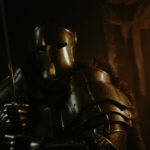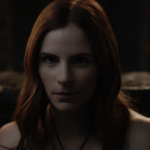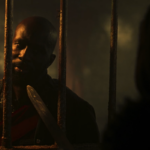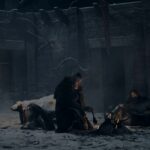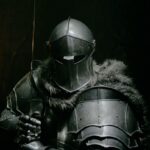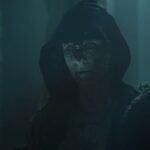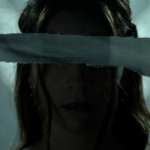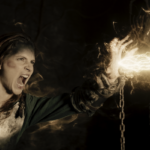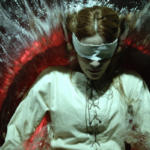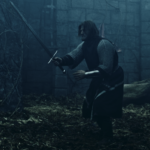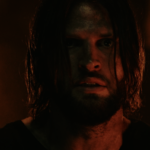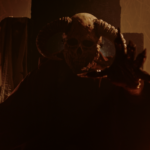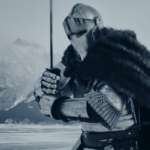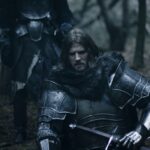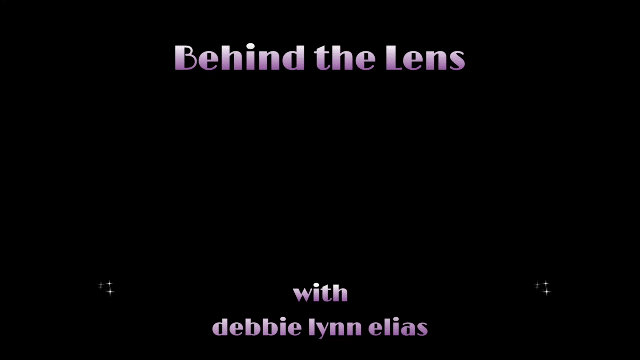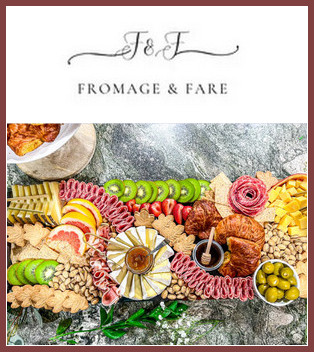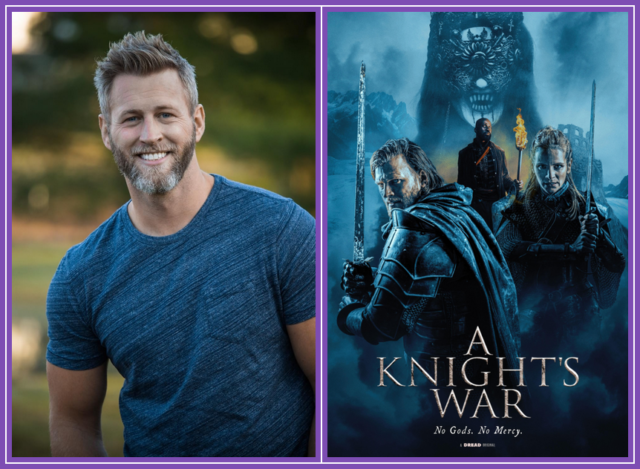
An exclusive in-depth interview with the multi-faceted director/writer/editor/actor MATTHEW NINABER discussing the atmospheric and immersive period piece, A KNIGHT’S WAR. It’s about time we see a knight in shining armor again!
SYNOPSIS: Bhodie, a knight born of questionable lineage yet bound by an unshakeable code, embarks on a daunting quest to rescue the tainted soul of the chosen one from the depths of the fallen realm. Negotiating a Faustian pact with the enigmatic gatekeeper of this infernal domain, Bhodie embarks on his own Odyssey, confronting a gauntlet of trials, battling witches, demons, barbarians, and the unforgiving landscape of hell itself. However, his resolve wavers as he discovers the true nature of the chosen one’s corruption – her return to the mortal realm threatens to unleash chaos and herald the resurgence of ancient gods. Faced with this moral dilemma, Bhodie must navigate the treacherous path between duty and the greater good, knowing that the fate of humanity hangs in the balance.
The fourth collaboration from the Ninaber brothers – director and co-writer MATT NINABER and co-writer Jeremy Ninaber – A KNIGHT’S WAR stars Jeremy Ninaber as Bhodie, Kristen Kaster as Avalon, Shane Nicely as The Gatekeeper, and Matt Ninaber as The Invoker. Matt also serves as editor on the film.
Energetic and enthusiastic, MATT NINABER is a joy to speak with. He is passionate about filmmaking and particularly A KNIGHT’S WAR, a film that he and his brother Jeremy dreamt of making since childhood thanks to their shared love of medieval tales, Old World lore, and knights of olde. Significant with A KNIGHT’S WAR is that the film is “hand made” as all sets were built by hand thanks to not only Matt and Jeremy, but their brother, production designer Ralph Ninaber. In fact, a good portion of the film was shot in Matt’s backyard where the castle you see in the film was built and still stands (hopefully for use in a sequel!). A fun factoid is that the castle is made of foam!
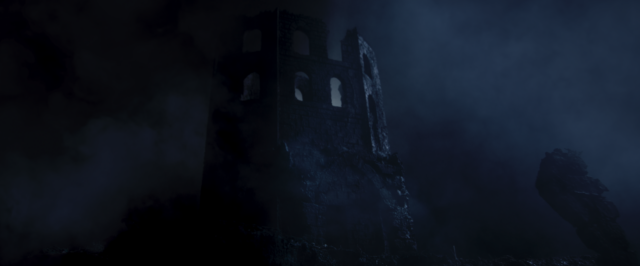
As Matt and I settled into our discussion, much of the conversation centered around the visuals and the atmosphere of the film. One of the wonderful cinematic aspects of medieval storytelling such as A KNIGHT’S WAR is that there are horror elements incorporated into inspirational legends which make for beautiful imagery when the story being told is in the hands of the right filmmaker. Matt Ninaber is the right filmmaker for this story and finds the perfect blend of swords and knights of olde with bloody fantastical legends and inky blue black torch-lit nights.
Drawing inspiration for the story from the origins of Lilith and other medieval lore including demons and otherwordly beliefs, it was important to Matt that the setting be transportive, immersing the audience in time and place. The production design, set decor, and cinematography were meticulously planned, with a focus on creating a detailed, lived-in world. Working with cinematographer Brent Tremain, the film’s visual grammar was developed through extensive camera tests, using real flames and vintage lenses. Adding to this world are the performances by Jeremy Ninaber and Kristen Kaster who trained for months before filming and performed their own stunts, using real swords. Sean Croley’s score complemented the story and characters effectively.
Diving into specifics of the filmmaking process for A KNIGHT’S WAR, we discussed, among others:
- achieving immersive visual ambience through detail and layering of elements to achieve almost a painterly quality
- inspiration from dark, Gothic imagery aimed to blend elegance and darkness in the production design
- all of the sets were built from scratch, drawing influences from sources like the new “Mad Max” film and Renaissance paintings to create a lived-in, medieval world
- close collaboration with the production designer, set decorator, and cinematographer to meticulously craft the details, from the distressed costumes and armor to the use of real flames and vintage Zeiss lenses
- filming in the dead of winter for the exterior scenes also contributed to the bleak, wintry aesthetic, requiring the crew to work in challenging conditions to capture the right look and feel
- costuming and mask designs
- costuming and mask design for the witches was a collaborative process between Matt and Darcie Kaster with each witch having her own distinct look, drawing inspiration from Renaissance paintings and the idea of them being more like fallen gods or priests rather than traditional witches. The masks were designed by a sculptor, and Darcie then built upon that foundation to add the detailed costumes that complement the masks and establish the visual identity of these key characters.
- developing a color palette
- Matt acting as “The Invoker”
- he had a clear vision for The Invoker and how he fit into the narrative
- playing the role himself allowed him to fully embody that character and ensure his presence on screen matched Matt’s creative intent
- the mask and headpiece for The Invoker was also custom made for Matt and with budgetary thought, it was prudent for Matt to play the role as the sculptor already had a cast of Matt’s head from a prior film (“Psycho Goreman”) and could use the same cast/mould to create The Invoker
- challenges of the fight choreography
- Jeremy and Kristen started working on the fight choreography 6 months before filming initially using plastic swords before becoming accomplished and secure enough to use real swords
- during early training they were not wearing armor but once they did, it significantly limited their movement and they had to redo a lot of the choreography to make it work with the armor
- physical demands of swinging real swords all day for 10-hour shoots
- using real broad swords was another element important to the authenticity of the film
- overall fight choreography required a lot of advance planning, physical training, and on-set adjustments to pull off the authentic, well-executed fight scenes in the film
- collaboration with cinematographer Brent Tremain and developing the visual grammar
- a lot of camera tests beforehand, experimenting with different lenses and seeing what would work best for the look and feel they wanted; dark, moody atmospheric, strong sense of place
- embracing using real flames on set, as they felt that would add an authentic, atmospheric quality that would be hard to replicate with digital effects
- use of vintage Zeiss lenses; paired really nicely with the real fire elements, giving the rich, painterly quality they sought
- shooting with the Red Komodo for its global shutter, which improved fight scenes’ quality
- exterior scenes required them to be strategic about the time of year the film was shot
- choosing the coldest, deadest time to get that barren, wintry look
- research of films with similar aesthetic taught them the key was getting up extremely early, filming from around 6-10am before the sun became too bright, then waiting for it to set again in the evening to pick up more shots
- remote locations that were difficult to get to
- score and working with composer Sean Croley
- the challenges of communicating and verbalizing what Matt wants when he is not a musician
- sound effects
- Sean’s developing individual musical motifs for Bhodie and Avalon and slowly melding those motifs in the third act to mirror the character development and emotional beats
- lessons learned
- and more!
TAKE A LISTEN. . .
by debbie elias, Exclusive Interview 01/31/2025
A KNIGHT’S WAR comes to limited theaters on February 7th, and is on digital February 11th from DREAD.

